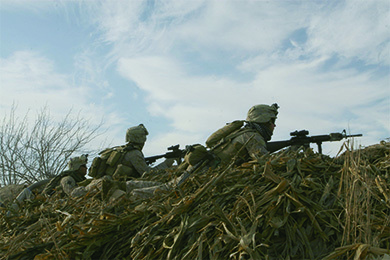| << Chapter < Page | Chapter >> Page > |

At the same time that the U.S. military was taking control of Afghanistan, the Bush administration was looking to a new and larger war with the country of Iraq. Relations between the United States and Iraq had been strained ever since the Gulf War a decade earlier. Economic sanctions imposed on Iraq by the United Nations, and American attempts to foster internal revolts against President Saddam Hussein’s government, had further tainted the relationship. A faction within the Bush administration, sometimes labeled neoconservatives, believed Iraq’s recalcitrance in the face of overwhelming U.S. military superiority represented a dangerous symbol to terrorist groups around the world, recently emboldened by the dramatic success of the al-Qaeda attacks in the United States. Powerful members of this faction, including Vice President Dick Cheney and Secretary of Defense Donald Rumsfeld, believed the time to strike Iraq and solve this festering problem was right then, in the wake of 9/11. Others, like Secretary of State Colin Powell, a highly respected veteran of the Vietnam War and former chair of the Joint Chiefs of Staff, were more cautious about initiating combat.
The more militant side won, and the argument for war was gradually laid out for the American people. The immediate impetus to the invasion, it argued, was the fear that Hussein was stockpiling weapons of mass destruction ( WMDs ): nuclear, chemical, or biological weapons capable of wreaking great havoc. Hussein had in fact used WMDs against Iranian forces during his war with Iran in the 1980s, and against the Kurds in northern Iraq in 1988—a time when the United States actively supported the Iraqi dictator. Following the Gulf War, inspectors from the United Nations Special Commission and International Atomic Energy Agency had in fact located and destroyed stockpiles of Iraqi weapons. Those arguing for a new Iraqi invasion insisted, however, that weapons still existed. President Bush himself told the nation in October 2002 that the United States was “facing clear evidence of peril, we cannot wait for the final proof—the smoking gun—that could come in the form of a mushroom cloud.” The head of the United Nations Monitoring, Verification and Inspection Commission, Hanx Blix, dismissed these claims. Blix argued that while Saddam Hussein was not being entirely forthright, he did not appear to be in possession of WMDs. Despite Blix’s findings and his own earlier misgivings, Powell argued in 2003 before the United Nations General Assembly that Hussein had violated UN resolutions. Much of his evidence relied on secret information provided by an informant that was later proven to be false. On March 17, 2003, the United States cut off all relations with Iraq. Two days later, in a coalition with Great Britain, Australia, and Poland, the United States began “Operation Iraqi Freedom” with an invasion of Iraq.

Notification Switch
Would you like to follow the 'U.s. history' conversation and receive update notifications?